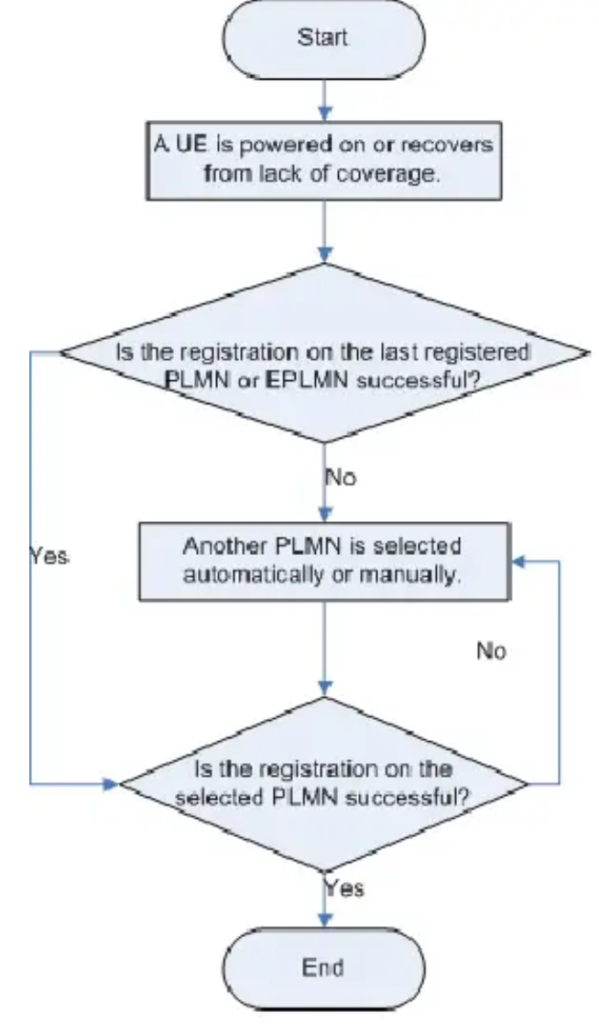PLMN Selection is a fundamental process in cellular networks, determining how a mobile device selects and registers with a network operator. It ensures that users are connected to the most suitable network based on availability, roaming agreements, and user preferences.
PLMN Selection
UEs select a Public Land Mobile Network (PLMN) and register on it. Figure below illustrates the PLMN selection procedure.

When a UE is powered on or returns from an area with no signal coverage:
- Initial Selection: The UE first selects the last Registered PLMN (RPLMN) or a PLMN from the Equivalent PLMN (EPLMN) list and attempts to register.
- Successful Registration: If registration on the selected PLMN is successful, the PLMN is displayed on the UE, allowing the UE to obtain services from the operator. If the last RPLMN is unavailable or registration fails, the UE can select another PLMN either automatically or manually based on the PLMN priority information stored in the USIM.
For detailed PLMN selection procedures, refer to section 4.4 in 3GPP TS 23.122.
Figure: PLMN Selection Procedure

PLMN Selection in Automatic Mode
If a UE fails to register on its most recent RPLMN or EPLMN, it attempts to select another PLMN. In automatic network selection mode, the UE selects a PLMN in the following preferential order:
- EHPLMN: The EHPLMN with the highest priority if the EHPLMN list is present and not empty, or the HPLMN if the EHPLMN list is absent or empty.
- User Controlled PLMN Selector: Each PLMN/radio technology combination in the User Controlled PLMN Selector with Access Technology data file in the USIM, in priority order.
- Operator Controlled PLMN Selector: Each PLMN/radio technology combination in the Operator Controlled PLMN Selector with Access Technology data file in the USIM, in priority order.
- High-Quality PLMNs: Other high-quality PLMN/radio technology combinations, in a random order. A combination is considered high-quality if the reference signal received power (RSRP) of a cell in the PLMN/radio technology combination is greater than or equal to –110 dBm.
- Other PLMNs: Other PLMN/radio technology combinations in order of decreasing signal quality.
When the UE finds a Suitable Cell in a PLMN following this procedure, it attempts to register. If successful, the UE camps on the Suitable Cell. Otherwise, it tries the next PLMN. If registration on none of the PLMNs is successful, the UE enters the Limited service state. If no PLMN is available, the UE cannot obtain any services.
NOTE: Limited service, Normal service, and Operator service are three service types that can be provided for UEs in idle mode in Acceptable Cell, Suitable Cell, and Reserved Cell, respectively. For details about Acceptable Cell, Suitable Cell, and Reserved Cell, refer to section 4.3 in 3GPP TS 36.304 R10, released in March 2011.
PLMN Selection in Manual Mode
If a UE fails to register on its most recent RPLMN or EPLMN, it attempts to select a new PLMN. In manual network selection mode, the UE displays a list of detected PLMNs in the same order as for automatic network selection.
In manual mode, the UE can also try forbidden PLMNs, which are determined by the EPC. If the UE successfully registers on the selected PLMN, the UE no longer considers the PLMN to be forbidden.
What are Types of PLMN Selection?
Automatic Selection
- The mobile device automatically selects a preferred network based on a predefined list of preferred PLMNs.
- This list is typically provided by the SIM card and prioritized based on the user’s home network and roaming agreements.
Manual Selection
- Users can manually choose a network from a list of available PLMNs detected by their device.
- This option is useful when the automatic selection does not connect to a preferred network, or if the user wants to connect to a specific network.
What is PLMN Selection Process?
Initial Network Selection
- When a device is powered on, it scans for available PLMNs.
- The device attempts to connect to the highest-priority network in the preferred list.
Periodic Reselection
- Devices periodically scan for better network options, especially if the current network quality degrades.
- The reselection process ensures optimal connectivity as users move across different areas.
Roaming
- When outside the home network, the device selects a network based on roaming agreements.
- Preferred roaming partners are prioritized to ensure seamless connectivity and potentially lower roaming charges.
What is Criteria for PLMN Selection?
Signal Strength and Quality
- Devices prioritize networks with the best signal strength and quality to ensure reliable communication.
Subscription Information
- The SIM card contains information about the preferred PLMNs and their priority levels.
- This information guides the device in selecting the most appropriate network.
Roaming Agreements
- Networks with established roaming agreements with the user’s home network are prioritized.
- This ensures continuity of service and cost-efficiency while roaming.
What are Challenges in PLMN Selection?
Network Congestion
- High traffic loads can affect the availability and quality of the selected network.
- Devices may need to reselect to less congested networks to maintain service quality.
Roaming Restrictions
- Some networks may have restrictions or limited agreements, affecting the availability of preferred networks.
- Users may experience limited connectivity options in such cases.
User Preferences
- Manual selection can be influenced by user preferences, which might not always align with optimal network performance.
- Balancing user preferences with network performance is essential for maintaining service quality.
PLMN Selection is a very important of cellular network operations, ensuring users connect to the most suitable network based on a combination of automatic and manual processes. By considering factors like signal quality, subscription information, and roaming agreements, mobile devices can provide reliable and efficient connectivity to users.
Effective PLMN selection strategies enhance user experience by ensuring consistent and high-quality network access, whether at home or while roaming internationally.